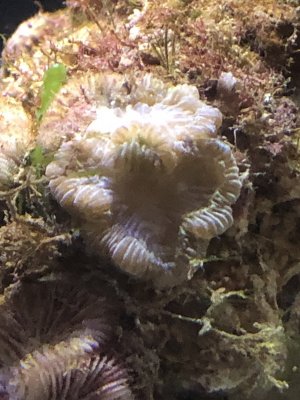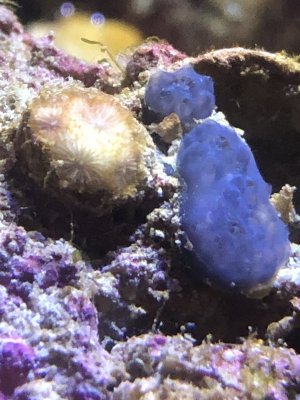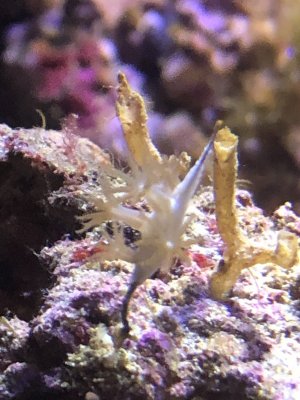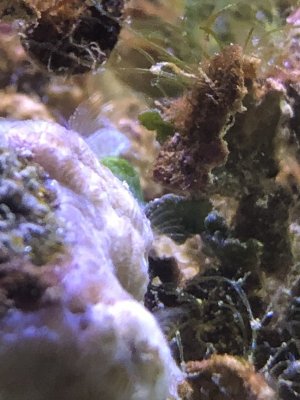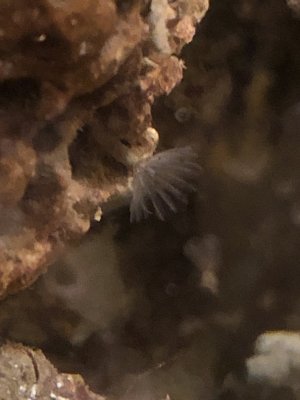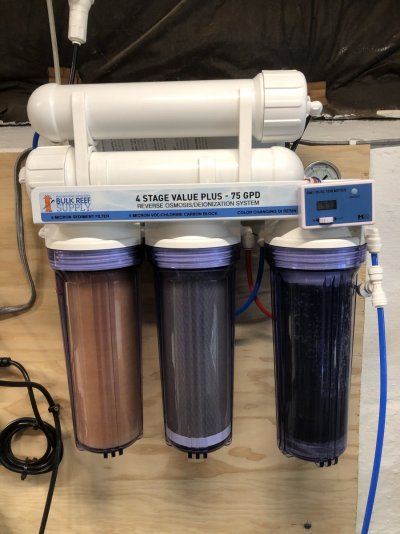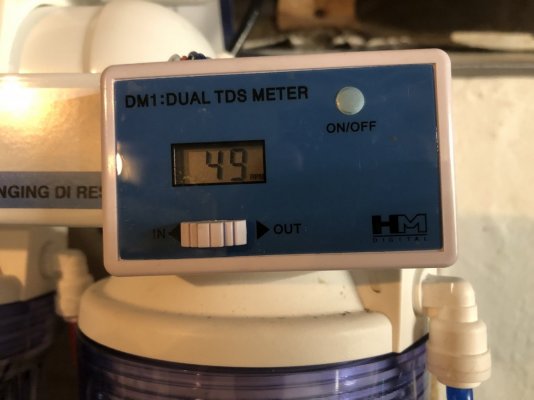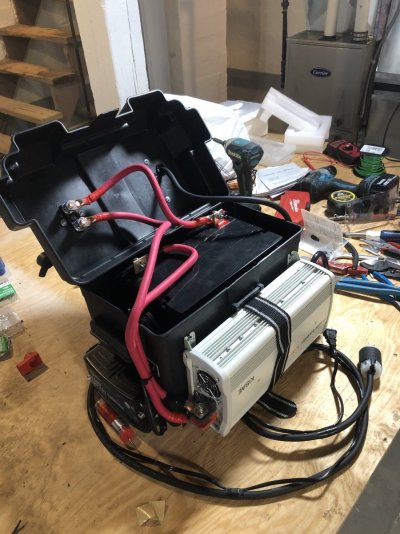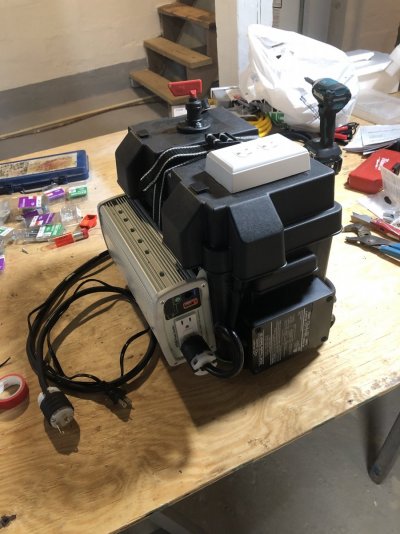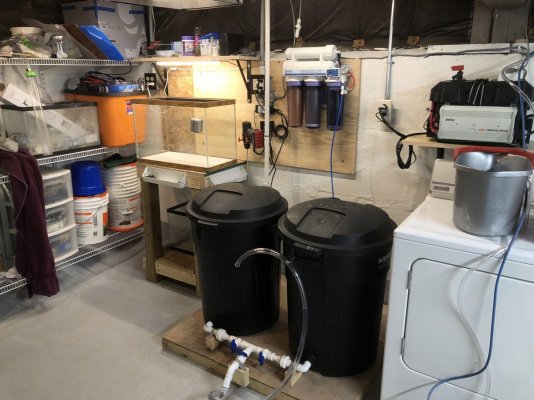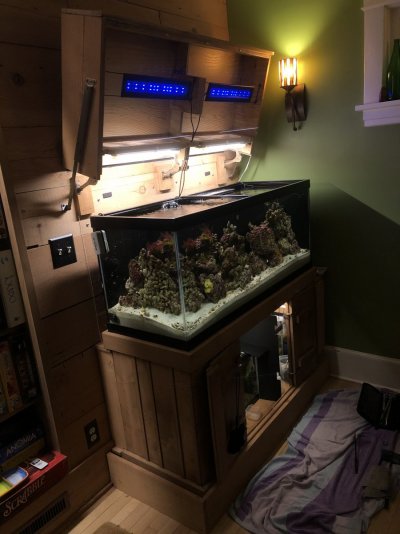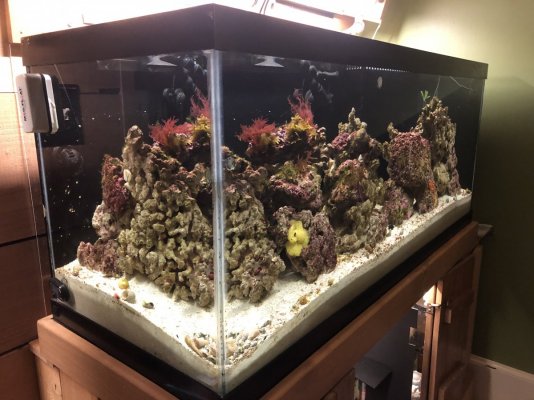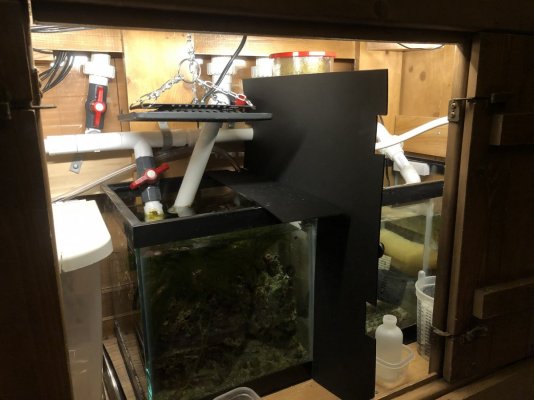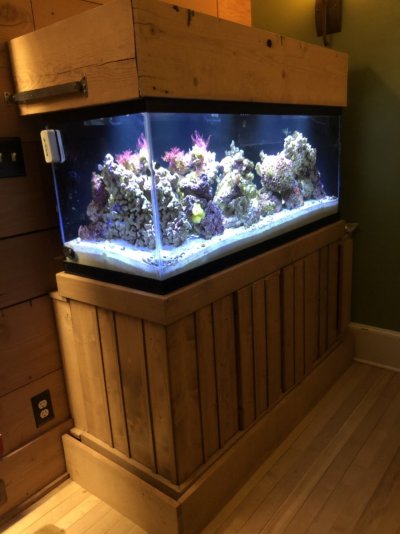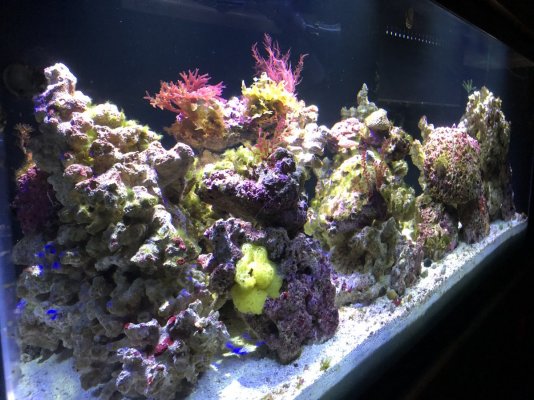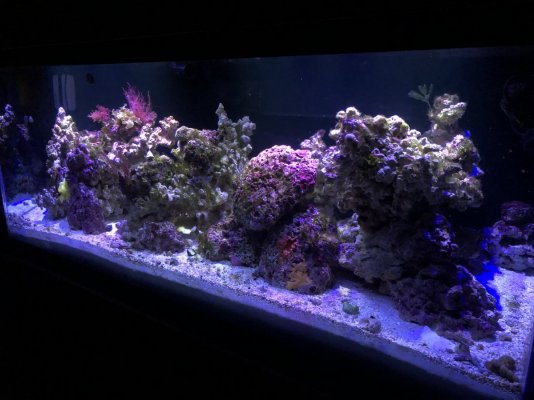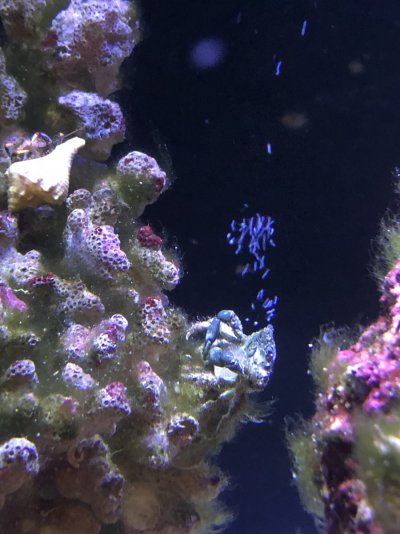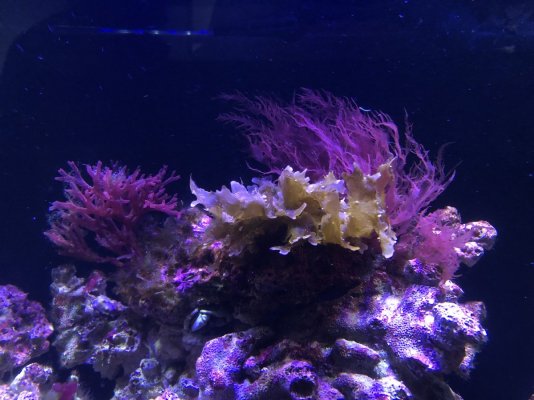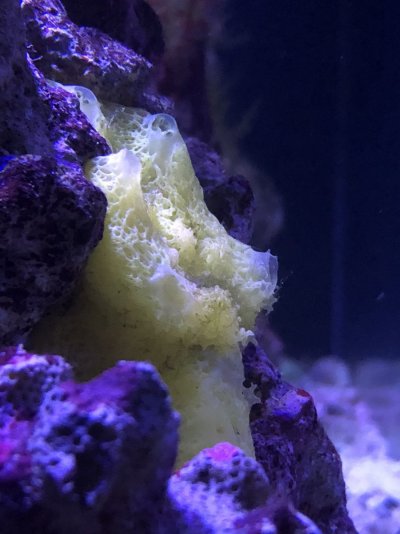Yo yo y'all!!
Hope you've been reefing hard, cause I sure have! Figured I should get this thread started while I am still in the progress of my first build. Some real time input from the savvy crew here at R2R would be more than welcome. The encouragement to start a build thread and the valuable feedback I have seen in other's threads is a very rewarding part of this community. I gave a bit of background in my intro, freshened up my profile with some details and now............the BUILD!!!!!!!
GOALS
From an early age the idea of a saltwater tank has always intrigued me, a thriving little piece of the ocean. Of course I eventually realized how complex that is in actuality, so many variables and parameters to get right or go wrong. But.....if you got it juuuuuust right.....it could be nearly self sustaining with little maintenance......right? I have come to the awareness as an adult of how realistic that is. Though possible, it's just not feasible for the average hobbyist, or a novice such as myself. This ideal has certainly guided my decision making through the process and has helped me set some key elements of success for the environment I am about to create. As a natural born tinkerer and a carpenter by trade, the DiY potential in this hobby caught my attention straightaway. And as a naturalistic minded individual, I want the best for my future salty critters. All of this has led me to these few goals(in no particular order):
Just gonna run down a quick list of current equipment I currently have purchased. Feel free to comment on things you see undersized or unnecessary, or anything I seem to be missing. I am still in the process of a dry fit/setup, so nothing is set in stone at this point.
Time to get to the meat of it all, the actual build process. The opportunity to make a dream a reality fell in my lap about 5 years ago. I was doing a bathroom remodel for a friend who also happened to be a freshwater aquarist and cichlid breeder. Was downsizing and getting out of breeding, so as partial payment I ended up with a 75gal tank and stand. He threw in a wet/dry sump he had sitting around as well. My inital plan was to get some new biomedia and use the sump. But after doing more research, decided against the wet/dry setup entirely. So the adventure begins with just the Perfecto: 75gal tank and Majesty stand.

Since I decided the wet/dry was not my best option, I needed to track down a tank for a sump. I wasn't about to consider dropping much $$ on some of the prefab sumps out there. Don't get me wrong, they are engineered and effective, just out of my budget for this project. So I called up my buddy, and sure enough, he had a 20g long tank for a sump as well as a 30g I could have for a quarantine tank. The main tank had sat in my garage for 5+ years. I had major home renovations planned and was just not ready for a tank at the time. With the years of garageness and some unknown messes in the new small tanks, a major clean was in order. I used a 5:1 water/vinegar solution and scrubbed the crap out of em, being mindful of the silicone seals. Got em all shiny and filled em with water for a week to test the seals.........YAAAAARRR!!1!!No leaks!!!! Time to move ahead.

I knew that wanted to minimize the equipment in and around the display tank, so an internal overflow seemed the best option. Of course the tank was not drilled. This led me to a nerve wracking web search, a couple phone calls and no real assurance that the 14 year old tank I had DID NOT have tempered glass walls. The bottom was clearly labeled as such, and any DIY tests I tried resulted with the same observations for bottom and sides. So I said "Screw it, worst comes to worst I shatter the glass and need to buy a new tank". I had purchased a few pieces of equipment but felt I could still back out of the whole project if the drilling went south and took the wind outta my sails. I have drilled glass before so I was comfortable with the process at least. So I laid out my overflow box and mocked up my drains to determine bulkhead spacing. It ened up being a bit tight, but workable. Got my holes marked out and my diamond hole saws ready. The 1" bulkheads for the drain required an 1 3/4" hole, the 3/4" return bulkhead needed 1 1/2" hole. Here goes nothing.......



BOOM!!!!! Drilled my first tank. Boy was I Nervous as I slowed down and let up towards the end of the first hole. I has set up a putty dam on the first one as I had seen in a couple tutorial vids. That ended up being a messy hassle for multiple holes, so I just used the template that came with the overflow box I purchased. I ended up clamping a board to the underside of the glass as well to catch the puck as well as help prevent chip out. Water was pour on to the drill site for a cooling lubricant, and wiped and reapplied as I drilled to gauge progress. Slow speed to start and low pressure though out is the key. Once the hole gets starts started, drill speed can increase until the end of the cut. Slowing down speed and letting off pressure at the end saves chip out and less micro fractures. Next step, the overflow and drains
I'm gonna leave it there for now, been working on this off and on for a couple days. There is more progress to show, and I will sooner than later have real time updates. I just wanna get the ground work out and get some buzz going and some feedback flowing.
That being said, I think I'd like to leave every post with some questions or open up a discussion on my project:
Hope you've been reefing hard, cause I sure have! Figured I should get this thread started while I am still in the progress of my first build. Some real time input from the savvy crew here at R2R would be more than welcome. The encouragement to start a build thread and the valuable feedback I have seen in other's threads is a very rewarding part of this community. I gave a bit of background in my intro, freshened up my profile with some details and now............the BUILD!!!!!!!
GOALS
From an early age the idea of a saltwater tank has always intrigued me, a thriving little piece of the ocean. Of course I eventually realized how complex that is in actuality, so many variables and parameters to get right or go wrong. But.....if you got it juuuuuust right.....it could be nearly self sustaining with little maintenance......right? I have come to the awareness as an adult of how realistic that is. Though possible, it's just not feasible for the average hobbyist, or a novice such as myself. This ideal has certainly guided my decision making through the process and has helped me set some key elements of success for the environment I am about to create. As a natural born tinkerer and a carpenter by trade, the DiY potential in this hobby caught my attention straightaway. And as a naturalistic minded individual, I want the best for my future salty critters. All of this has led me to these few goals(in no particular order):
- DiY the crap outta this thang - There are so many components to a reef tank build that can be crafted/modified/improved through a bit of research, ingenuity, patients and skill. I plan to take advantage of my abilities in this regard. It is incredibly thrilling to me to be building this biological machine. I also feel that the more involved you are in the setup and build of as many elements of the system that you can, the potential for solving problems and making modifications is that much greater. And of course the "idea" is that there should be cost saving associated with the concept. Hence.......
- Budget - Lets be realistic, this isn't a poor man's sport. Of course, like any good immersive hobby, there is a scale of costs associated. My wife and I are not well off, but we certainly aren't struggling. This whole dream tank idea is solely mine to own in victory or defeat. However, I will allow her to enjoy its calming beauty when this thing get rolling. That, and my frugal nature, is what drives me to keep this project to a reasonable level of expenditure. Top of the line anything in life is not my style. The tank build is no exception. There are no hard numbers or goals in this regard, just try to build what you can and whatcha gotta buy, don't buy cheap and don't break the bank. Though good in theory, the pile of receipts is kinda staggering. The equipment/parts list is ever growing and evolving, but sticks to one crucial ideal...
- Keep It Simple Stoopid - I believe that complex systems are easy to over complicate. So this ideal is tricky to apply to marine aquariums. But I think if its broken down into 4 key elements of water, light, waste management and livestock, it can be far easier to manage. RODI water will be purchased initially with the intention of setting up my own filtration system eventually. I will setup a mixing station for salt water. My lights are lower end LEDs that I may supplement eventually with other lighting, depending on success and future needs. I plan in relying on mostly biological filtration. There will be a skimmer in the sump, but that will be it for mechanical filtration. I do not plan on any reactors or chemical filtration, but have a return manifold in the works just in case. Water changes will be on a regular schedule, though ideally not often. Dosing is not something I want to have to do, but will consider it based on inhabitants. All of these elements will help guide me to what possible livestock options I have. The more I learn how these main aspects interact with each other the more equipped I am to keep it simple. To have realistic view of the balance between them can help eliminate many unattainable goals. That being said.....
- CRITTERS!!! - One of the most fascinating aspects of the marine environment is the diversity and sure concentration of life. Everything from minuscule microbes to flashy fish play a vital role in that biodiversity. And that is what we try to replicate in our tanks. I have always been more intrigued by the creatures in, on and around the live rock and substrate than the fish when I am peeking and peering into every shadowy crevice I can. What we refer to as “getting tanked” amongst a few of my friends. I could honesty enjoy just some quality live rock and a clean up crew for some time. I plan on tracking down some aquacultured gulf rock and some good live sand. Then enlist a solid CUC to help keep things in order. As far as corals go, I'd like to achieve a good mixed reef blend of softies, LPS, a few SPS and maybe attempt some NPS. Fish I plan to keep to a minimum, more for function than flash. The only really aesthetic goals in that area are a small group of schooling fish and a Mandarin Dragonette. Otherwise only fish that perform a function (pest control, algae control...) in the tank. I know fish play a role in providing a needed bioload within the system, so that will need to be a balancing act for me. I have a refugium section in my sump which I plan to have some macro algae and some pod propagation in. As far as sourcing goes, we lack a good LFS here in Dulth, so I will have to order and ship much of it. There are some good shops within a couple hour drive that I will probably hit up for most of the fish and frags. I would like to try and raise only aquacultured or tank bred livestock. There is much debate about the quality and ecocolgy of wild harvested specimens, but I would like to minimize my impact on the natural environment that I am attempting to recreate and appreciate.
Just gonna run down a quick list of current equipment I currently have purchased. Feel free to comment on things you see undersized or unnecessary, or anything I seem to be missing. I am still in the process of a dry fit/setup, so nothing is set in stone at this point.
- Tank - Perfecto; 75gal w/stand, 48x18x21
- Sump - Aqueon; 20gal long, DIY baffles and design
- Overflow - ReefCreators; 1800gph internal box
- Return - Current USA; eFlux 6009 DC pump, 1050gph max
- Flow - Current USA; 1- eFlux 6005, 2- eFlux 6004
- Lighting - Current USA; Orbit Marine IC PRO, Dual 24"
- Skimmer - Reef Octopus; Classic 110-INT
- Heat - BRS; 2- 300W titanium heaters ~ Inkbird; ITC-306T controller
- ATO - Tunze; 5000.020 metering pump ~ AquaHub; Top-It-Off Premium kit, DIY 2.5gal resevoir
- Thermometer and ground probe also ready for install
Time to get to the meat of it all, the actual build process. The opportunity to make a dream a reality fell in my lap about 5 years ago. I was doing a bathroom remodel for a friend who also happened to be a freshwater aquarist and cichlid breeder. Was downsizing and getting out of breeding, so as partial payment I ended up with a 75gal tank and stand. He threw in a wet/dry sump he had sitting around as well. My inital plan was to get some new biomedia and use the sump. But after doing more research, decided against the wet/dry setup entirely. So the adventure begins with just the Perfecto: 75gal tank and Majesty stand.
Since I decided the wet/dry was not my best option, I needed to track down a tank for a sump. I wasn't about to consider dropping much $$ on some of the prefab sumps out there. Don't get me wrong, they are engineered and effective, just out of my budget for this project. So I called up my buddy, and sure enough, he had a 20g long tank for a sump as well as a 30g I could have for a quarantine tank. The main tank had sat in my garage for 5+ years. I had major home renovations planned and was just not ready for a tank at the time. With the years of garageness and some unknown messes in the new small tanks, a major clean was in order. I used a 5:1 water/vinegar solution and scrubbed the crap out of em, being mindful of the silicone seals. Got em all shiny and filled em with water for a week to test the seals.........YAAAAARRR!!1!!No leaks!!!! Time to move ahead.
I knew that wanted to minimize the equipment in and around the display tank, so an internal overflow seemed the best option. Of course the tank was not drilled. This led me to a nerve wracking web search, a couple phone calls and no real assurance that the 14 year old tank I had DID NOT have tempered glass walls. The bottom was clearly labeled as such, and any DIY tests I tried resulted with the same observations for bottom and sides. So I said "Screw it, worst comes to worst I shatter the glass and need to buy a new tank". I had purchased a few pieces of equipment but felt I could still back out of the whole project if the drilling went south and took the wind outta my sails. I have drilled glass before so I was comfortable with the process at least. So I laid out my overflow box and mocked up my drains to determine bulkhead spacing. It ened up being a bit tight, but workable. Got my holes marked out and my diamond hole saws ready. The 1" bulkheads for the drain required an 1 3/4" hole, the 3/4" return bulkhead needed 1 1/2" hole. Here goes nothing.......
BOOM!!!!! Drilled my first tank. Boy was I Nervous as I slowed down and let up towards the end of the first hole. I has set up a putty dam on the first one as I had seen in a couple tutorial vids. That ended up being a messy hassle for multiple holes, so I just used the template that came with the overflow box I purchased. I ended up clamping a board to the underside of the glass as well to catch the puck as well as help prevent chip out. Water was pour on to the drill site for a cooling lubricant, and wiped and reapplied as I drilled to gauge progress. Slow speed to start and low pressure though out is the key. Once the hole gets starts started, drill speed can increase until the end of the cut. Slowing down speed and letting off pressure at the end saves chip out and less micro fractures. Next step, the overflow and drains
I'm gonna leave it there for now, been working on this off and on for a couple days. There is more progress to show, and I will sooner than later have real time updates. I just wanna get the ground work out and get some buzz going and some feedback flowing.
That being said, I think I'd like to leave every post with some questions or open up a discussion on my project:
- Are there any glaring conflicts or missing components in my equipment list?
- What are some recommendations for small schooling fish in a lightly populate tank, ideal for a beginner?
Last edited:






